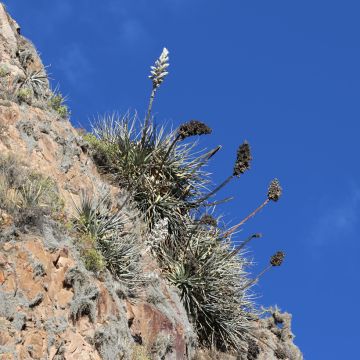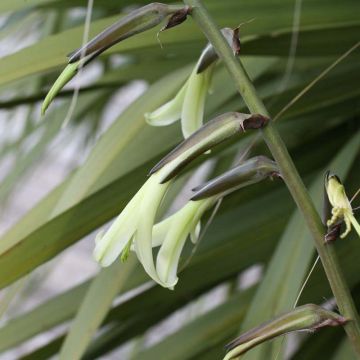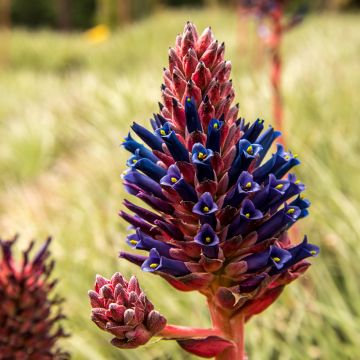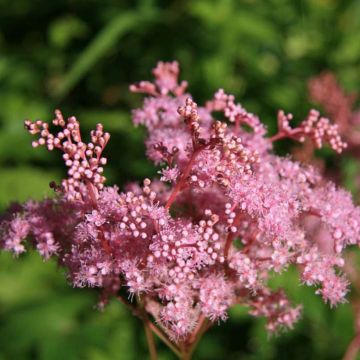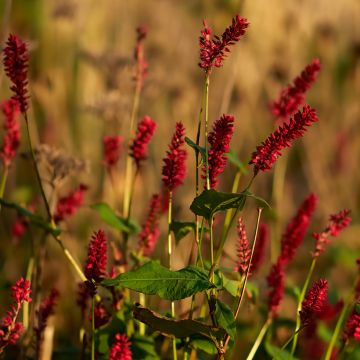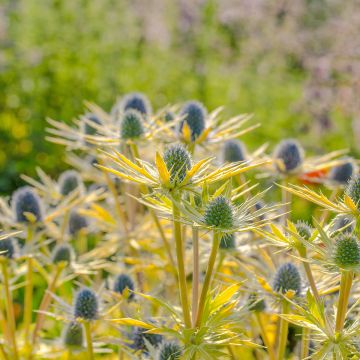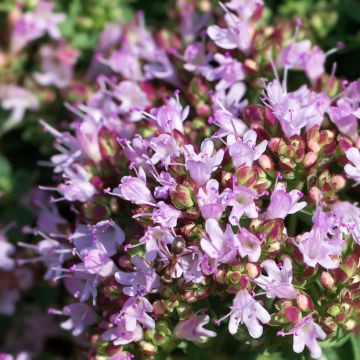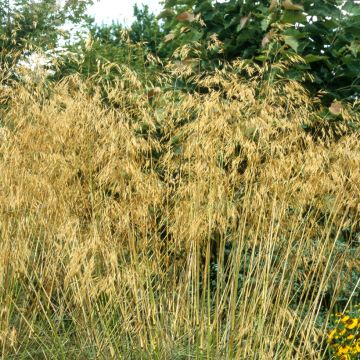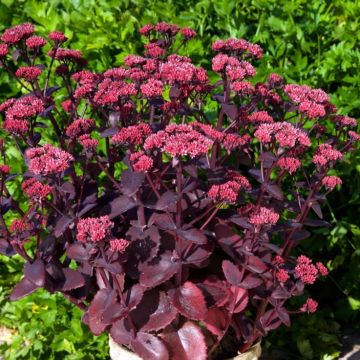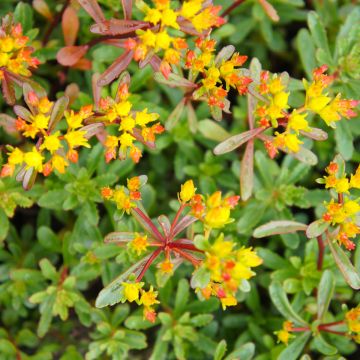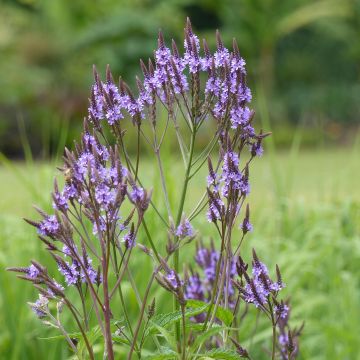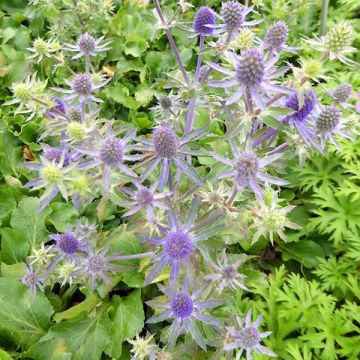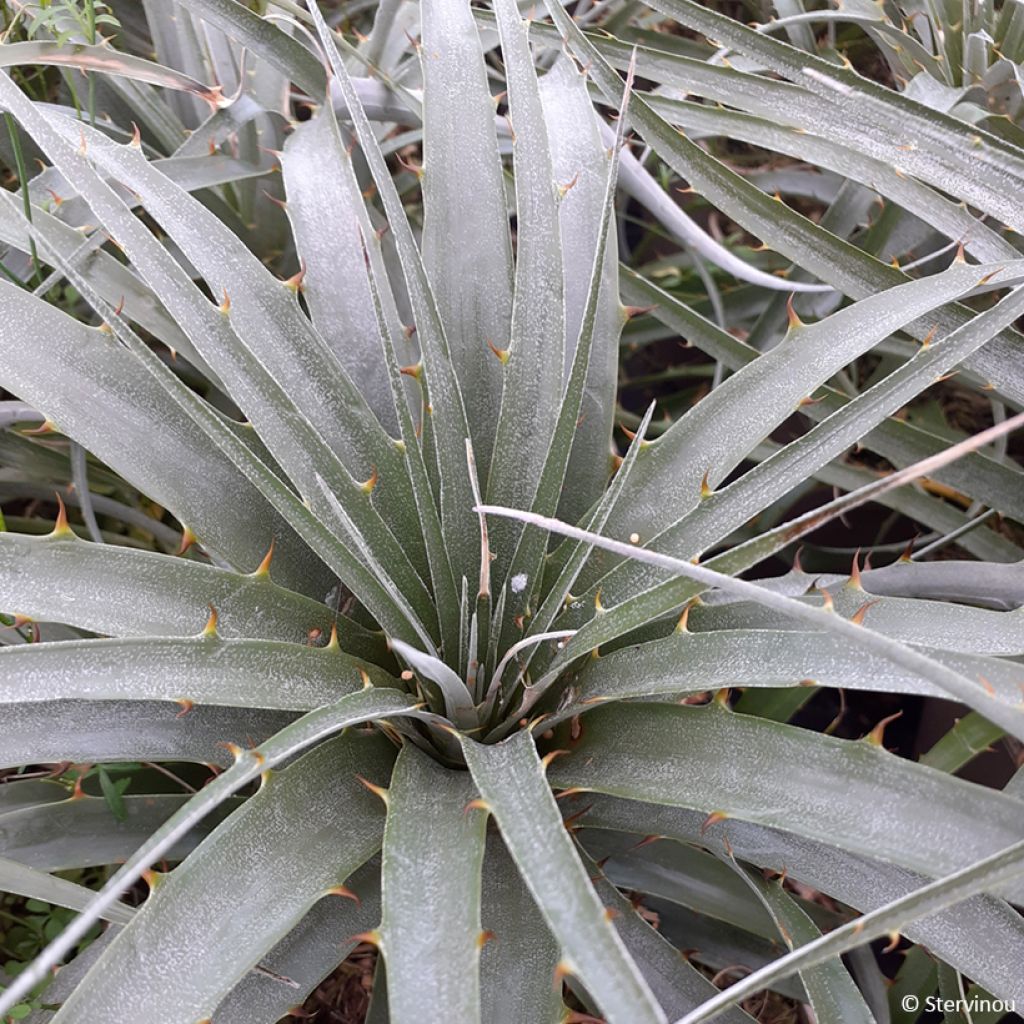

Puya weberiana
Puya weberiana
Puya weberiana
Weber's Puya, Weber's Bromeliad
This item cannot be shipped to the selected country
Delivery charge from €5.90
More information
Schedule delivery date,
and select date in basket
This plant carries a 12 months recovery warranty
More information
We guarantee the quality of our plants for a full growing cycle, and will replace at our expense any plant that fails to recover under normal climatic and planting conditions.
From €5.90 for pickup delivery and €6.90 for home delivery
Express home delivery from €8.90.
Does this plant fit my garden?
Set up your Plantfit profile →
Description
Puya weberiana, or Weber's puya, is a rare and spectacular bromeliad native to the arid mountains of Argentina. Its flowering is impressive: it takes the form of a huge spike filled with pink bracts and tiny blue flowers, emerging from a rosette of silvery green-gray. Drought-resistant but sensitive to heavy frosts, it is an ideal ornamental plant for dry or Mediterranean gardens. Its uniqueness will be fully expressed in a rockery or a mineral setting. In cooler regions, grow it in a pot that you will store away in winter.
Puya weberiana belongs to the Bromeliaceae family. This botanical species grows in the rocky Andean meadows at high altitudes, notably in the provinces of Salta and Tucumán, Argentina. It is a perennial plant without stems, slow-growing. It forms a rosette of leaves that usually measures between 60 cm and 1 m in all directions. The narrow leaves are green on top and silvery underneath, with small reddish hooked teeth along the edges. This foliage persists in winter. What makes this plant particularly impressive is its inflorescence that can reach up to 2.5 m in height. Like other Puyas, flowering occurs in summer on mature plants several years old. The inflorescence features many bright pink woolly-looking floral bracts, stacked on top of each other. The flowers themselves are small, tubular, ranging from mauve-blue to pink, highly nectariferous. The bracts remain decorative for several months, earning this plant the nickname "desert lantern". This Puya's hardiness is estimated at -6°C in well-draining soil. The plant often perpetuates itself through the development of daughter rosettes that grow near the base.
Puya weberiana is a collector's plant to showcase in a rockery or gravel garden in mild climates, especially on the Mediterranean coast. To accompany it, consider, for example, Yuccas, Dasylirions, Phormiums, and Nolina nelsonii. This unusual plant will make a big impact on a terrace, in a cactus soil mix, where it will stand out in a large pot. At the first signs of cold weather, store it away, handling it with care due to its thorns, in a greenhouse or conservatory.
Report an error about the product description
Flowering
Foliage
Plant habit
Botanical data
Puya
weberiana
Bromeliaceae
Weber's Puya, Weber's Bromeliad
South America
Other Puya
Planting and care
The Puya weberiana is preferably planted in spring. Choose a sunny location. Plant it in a soil that is perfectly drained, enriched with pumice, compost, and gravel. It will be hardy down to -6 °C if the soil is nearly dry in winter. To protect it from rain, place a thick mulch at its base and a plastic sheet over the rosette. In summer, it fears the combination of heat and excessive soil moisture that causes its roots to rot. Once established, this Puya generally does without watering in summer. In our very dry regions, occasional watering will be welcome, as well as a foliage shower at the end of a hot day. It is quite tolerant of the soil's pH, which can be acidic, neutral, or slightly chalky.
Growing in pots: prepare a large container with a drainage hole that you will fill with a combination of compost, sand, and pumice. You can also use cactus soil. Water regularly, without overdoing it. Add some cactus or succulent fertilizer to the watering water in spring.
Planting period
Intended location
Care
This item has not been reviewed yet - be the first to leave a review about it.
Summer flowering perennials
Haven't found what you were looking for?
Hardiness is the lowest winter temperature a plant can endure without suffering serious damage or even dying. However, hardiness is affected by location (a sheltered area, such as a patio), protection (winter cover) and soil type (hardiness is improved by well-drained soil).

Photo Sharing Terms & Conditions
In order to encourage gardeners to interact and share their experiences, Promesse de fleurs offers various media enabling content to be uploaded onto its Site - in particular via the ‘Photo sharing’ module.
The User agrees to refrain from:
- Posting any content that is illegal, prejudicial, insulting, racist, inciteful to hatred, revisionist, contrary to public decency, that infringes on privacy or on the privacy rights of third parties, in particular the publicity rights of persons and goods, intellectual property rights, or the right to privacy.
- Submitting content on behalf of a third party;
- Impersonate the identity of a third party and/or publish any personal information about a third party;
In general, the User undertakes to refrain from any unethical behaviour.
All Content (in particular text, comments, files, images, photos, videos, creative works, etc.), which may be subject to property or intellectual property rights, image or other private rights, shall remain the property of the User, subject to the limited rights granted by the terms of the licence granted by Promesse de fleurs as stated below. Users are at liberty to publish or not to publish such Content on the Site, notably via the ‘Photo Sharing’ facility, and accept that this Content shall be made public and freely accessible, notably on the Internet.
Users further acknowledge, undertake to have ,and guarantee that they hold all necessary rights and permissions to publish such material on the Site, in particular with regard to the legislation in force pertaining to any privacy, property, intellectual property, image, or contractual rights, or rights of any other nature. By publishing such Content on the Site, Users acknowledge accepting full liability as publishers of the Content within the meaning of the law, and grant Promesse de fleurs, free of charge, an inclusive, worldwide licence for the said Content for the entire duration of its publication, including all reproduction, representation, up/downloading, displaying, performing, transmission, and storage rights.
Users also grant permission for their name to be linked to the Content and accept that this link may not always be made available.
By engaging in posting material, Users consent to their Content becoming automatically accessible on the Internet, in particular on other sites and/or blogs and/or web pages of the Promesse de fleurs site, including in particular social pages and the Promesse de fleurs catalogue.
Users may secure the removal of entrusted content free of charge by issuing a simple request via our contact form.
The flowering period indicated on our website applies to countries and regions located in USDA zone 8 (France, the United Kingdom, Ireland, the Netherlands, etc.)
It will vary according to where you live:
- In zones 9 to 10 (Italy, Spain, Greece, etc.), flowering will occur about 2 to 4 weeks earlier.
- In zones 6 to 7 (Germany, Poland, Slovenia, and lower mountainous regions), flowering will be delayed by 2 to 3 weeks.
- In zone 5 (Central Europe, Scandinavia), blooming will be delayed by 3 to 5 weeks.
In temperate climates, pruning of spring-flowering shrubs (forsythia, spireas, etc.) should be done just after flowering.
Pruning of summer-flowering shrubs (Indian Lilac, Perovskia, etc.) can be done in winter or spring.
In cold regions as well as with frost-sensitive plants, avoid pruning too early when severe frosts may still occur.
The planting period indicated on our website applies to countries and regions located in USDA zone 8 (France, United Kingdom, Ireland, Netherlands).
It will vary according to where you live:
- In Mediterranean zones (Marseille, Madrid, Milan, etc.), autumn and winter are the best planting periods.
- In continental zones (Strasbourg, Munich, Vienna, etc.), delay planting by 2 to 3 weeks in spring and bring it forward by 2 to 4 weeks in autumn.
- In mountainous regions (the Alps, Pyrenees, Carpathians, etc.), it is best to plant in late spring (May-June) or late summer (August-September).
The harvesting period indicated on our website applies to countries and regions in USDA zone 8 (France, England, Ireland, the Netherlands).
In colder areas (Scandinavia, Poland, Austria...) fruit and vegetable harvests are likely to be delayed by 3-4 weeks.
In warmer areas (Italy, Spain, Greece, etc.), harvesting will probably take place earlier, depending on weather conditions.
The sowing periods indicated on our website apply to countries and regions within USDA Zone 8 (France, UK, Ireland, Netherlands).
In colder areas (Scandinavia, Poland, Austria...), delay any outdoor sowing by 3-4 weeks, or sow under glass.
In warmer climes (Italy, Spain, Greece, etc.), bring outdoor sowing forward by a few weeks.

































